By visiting our site, you agree to our privacy policy regarding cookies, tracking statistics, etc.
Whether you’re a seasoned restaurateur or new to the industry, mastering your restaurant’s back of house (BOH) operations is key to streamlining operations, enhancing the guest experience, and boosting profits.
Get an inside look at a restaurant’s BOH operations and discover how modern restaurant technology can help save time and drive growth.
Picture the BOH as the beating heart of a restaurant, where culinary skill unfolds with precision. It’s a dynamic hub bustling with chefs, line cooks, and dishwashers, all collaborating to craft each dish to perfection, ensuring excellence in quality, consistency, and service.
The seamless functioning of BOH operations is pivotal to the overall success of a restaurant. From managing inventory to controlling costs and staff training, every aspect must be carefully monitored to keep operations smooth.
In a restaurant, the term “back of house” refers to the area where food preparation, cooking, and other behind-the-scenes activities take place. This part of the restaurant is typically out of sight for guests and includes the kitchen, storage areas, and staff-only sections.
The BOH encompasses a variety of roles essential to the restaurant’s operations, such as chefs, line cooks, prep cooks, dishwashers, and kitchen managers. These team members are responsible for ensuring that food is prepared safely, efficiently, and to the highest quality standards.
While a restaurant’s BOH team is often overlooked because they are not seen by guests, they play a vital role in the overall dining experience. The coordination and efficiency of the BOH are crucial for maintaining smooth service and delivering a positive experience to guests.
The front of house (FOH) and back of house are two integral parts of a restaurant, each playing distinct roles that contribute to the overall dining experience. The FOH includes all areas and staff that interact directly with guests, such as the dining area, bar, host station, and servers. This team is responsible for creating a welcoming atmosphere, providing excellent service, and ensuring guest satisfaction.
In contrast, the BOH comprises the kitchen, storage areas, and staff-only sections where food preparation and behind-the-scenes activities occur.
While the FOH focuses on guest interaction and service, the BOH ensures the quality and consistency of the food. Both areas must work seamlessly together to deliver a memorable dining experience, highlighting the importance of communication and coordination between the two teams.
The head chef oversees the entire kitchen, developing menus and ensuring quality control, while the sous chef assists in managing daily tasks and supervising staff. Line cooks prepare specific menu items, and prep cooks handle ingredient preparation to streamline cooking processes. Dishwashers maintain cleanliness and ensure a steady supply of clean dishes, and pastry chefs specialize in creating desserts and baked goods. Specialty chefs focus on specific cuisines or techniques, bringing unique flavors and expertise to the menu. The kitchen manager handles administrative tasks, inventory, and overall kitchen coordination to ensure smooth operations.
Together, a restaurant’s back of house team members ensure that the kitchen runs efficiently, maintaining high standards of food quality and safety, which are crucial for delivering an exceptional dining experience.
Back of house positions are essential for the seamless operation and success of any dining establishment. This team includes various roles such as:
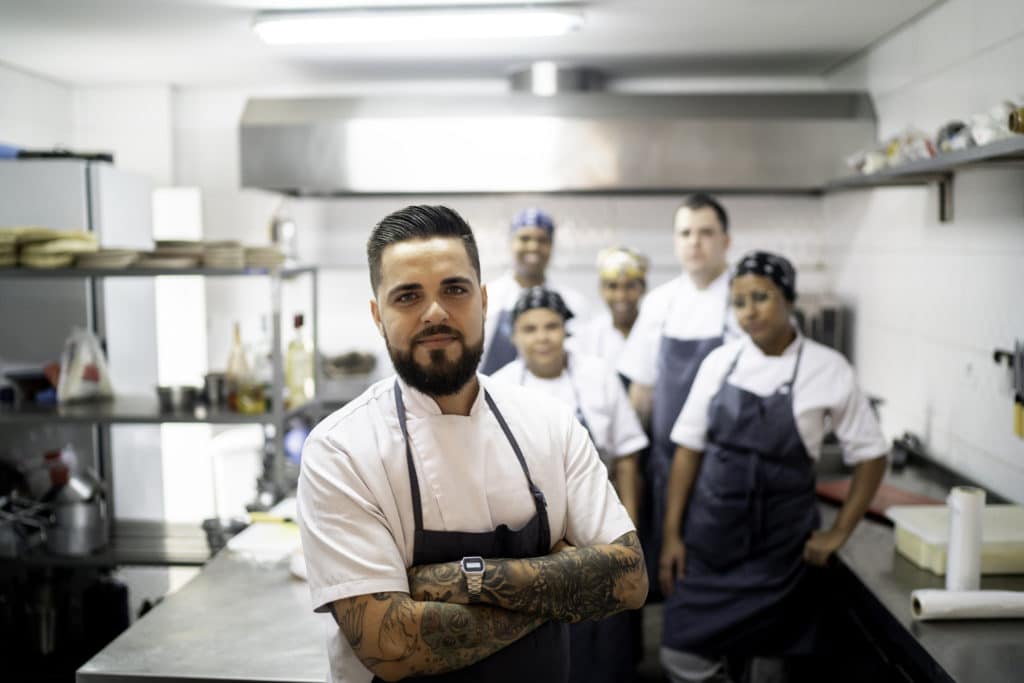
Back of house staff are the backbone of any restaurant, responsible for ensuring that every dish meets a restaurant’s standards for quality and consistency. Their duties range from food preparation and cooking to maintaining cleanliness and organization.
Effective BOH staff must be highly skilled, coordinated, and able to work under pressure, especially during peak hours. The use of modern kitchen technology and training platforms further enhances their efficiency, allowing for better communication, precise execution of recipes, and adherence to food safety standards.
By fostering a collaborative and well-trained BOH team, restaurants can deliver exceptional dining experiences and maintain high operational standards.
From the bustling kitchen to the intricacies of finance and marketing, each management position in the back of house plays a vital role in the success of any restaurant.
Away from the frenetic pace of the kitchen, back of house managers take charge of diverse responsibilities, ranging from inventory management to staff training. Their leadership not only upholds the pinnacle of quality and service but also cultivates a culture of excellence among the team, driving both productivity and guest satisfaction to soaring heights.
Assistant managers serve as the backbone of restaurant efficiency, navigating the complexities of inventory, staffing, and logistics. Their adept handling of day-to-day operations ensures smooth service and a flawless dining experience for guests.
Marketing teams behind the scenes breathe life into culinary creations, crafting compelling campaigns that draw diners through the doors. Through strategic branding, social media engagement, and innovative promotions, they are responsible for cultivating a loyal guest base and driving business growth.
When it comes to finances, accountants are responsible for crunching numbers and providing invaluable insights that inform strategic decisions and drive profitability. Their management of budgets, expenses, and financial reporting ensures the restaurant’s long-term success and sustainability.
The role of the owner can vary from restaurant to restaurant, but they generally oversee the back of house, managing inventory, kitchen operations, and staff. They set high standards for cleanliness and efficiency while encouraging their team to strive for excellence. With a focus on innovation and quality, owners ensure their establishment maintains its reputation for culinary creativity and profitability.
Operators, also known as district managers, oversee the operations of multiple stores within a specific geographic area. They are responsible for analyzing reports from various locations, identifying discrepancies, and implementing best practices across all stores. If they see certain locations are operating more efficiently, they’ll investigate the differences to ensure all stores adopt those successful strategies. Their role is crucial in maintaining consistency, improving efficiency, and ensuring each location meets the company’s high standards of quality and performance.
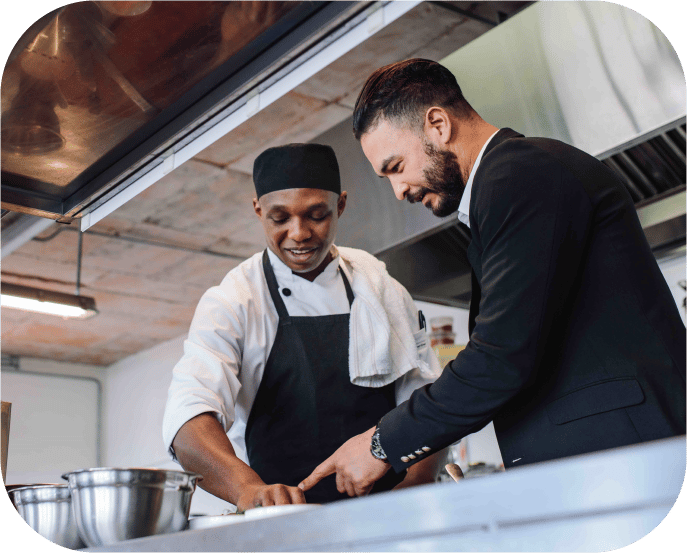
The heartbeat of any restaurant is its back of house, where a dedicated team tirelessly keeps the engine running smoothly. In a fast-paced kitchen environment, chefs, sous chefs, and line cooks work their culinary magic, crafting each dish with precision and care. From prepping food items to firing entrees, every step is executed with finesse to deliver memorable dining experiences.
Yet, the back of house extends far beyond the kitchen. Dishwashers diligently scrub pots and pans, ensuring a steady flow of clean equipment. Pantry chefs work hard to stock ingredients, keeping the kitchen well-supplied for seamless service. From managing inventory to upholding cleanliness standards, every task is crucial in maintaining the restaurant’s reputation for excellence. It’s the collective effort of these unsung heroes that keeps the restaurant running efficiently, creating an unforgettable experience for every guest who walks through the door.
In the kitchen, every member of the team plays a vital role in creating culinary masterpieces. From the head chef crafting the menu to the line cooks working their stations with precision, each person contributes to the magic of the dining experience.
The back of house kitchen crew works hard to keep everything running smoothly. Sous chefs manage the flow, ensuring everything goes seamlessly. Line cooks whip up delicious dishes with skill and precision, while prep cooks get all the ingredients ready. Meanwhile, dishwashers make sure everything stays sparkling clean. It’s a real team effort to keep the kitchen operating efficiently.
Leadership is key to ensuring the smooth operation of a restaurant’s kitchen and supporting areas. Back of house managers oversee a wide range of responsibilities, from staff scheduling and training to inventory management and maintaining health and safety standards.
One of the primary duties of back of house managers is to coordinate staffing needs, ensuring that the kitchen is adequately staffed to handle the demands of service. This involves creating schedules that balance workload and staff availability while also overseeing hiring and training processes to onboard new team members effectively.
Inventory management is another critical aspect of back of house management. Managers are responsible for monitoring food and supply levels, placing orders with vendors as needed, and ensuring that inventory is properly rotated to minimize waste and maintain freshness.
Back of house managers also play a crucial role in maintaining health and safety standards in the kitchen. This includes implementing and enforcing sanitation protocols, conducting regular inspections to identify and address any potential hazards, and ensuring that all staff are trained in proper food handling and safety procedures.
Ultimately, this team is integral to the success of a restaurant, ensuring that the kitchen runs smoothly, staff are well-trained and supported, and guests enjoy a safe and memorable dining experience.
Paying close attention to the details and having solid financial know-how are key to keeping a restaurant’s finances in good shape. Back of house accountants oversee budget management, financial reporting, payroll processing, and vendor invoicing.
They keep the restaurant’s finances on track by monitoring expenses, analyzing financial data, and creating budgets that match their goals. Financial reporting includes preparing profit and loss statements and balance sheets to evaluate performance. They also handle payroll, making sure staff get paid accurately and on time.
Additionally, they handle vendor invoices, verifying accuracy and processing payments promptly. Bottom line—back of house accountants play a vital role in ensuring the restaurant’s financial stability and success by managing budgets, reporting, payroll, and vendor transactions.
Restaurant inventory management is the engine that keeps a foodservice business running smoothly, ensuring ingredients are on hand while keeping waste and costs in check. It’s about meticulously tracking everything from deliveries to plate, knowing what’s in stock, what’s flying off the shelves, and what’s on the horizon to avoid running out or overstocking.
With the right approach, restaurant owners and managers can streamline operations and boost profits. Modern technology offers tools like automated ordering and real-time reporting, making inventory tasks simpler and smarter. These solutions provide restaurants with necessary insights into their inventory levels, empowering them to make well-informed decisions and ensure seamless supply chain management.
But it’s not just about numbers and orders—effective inventory management is also about ensuring food safety and quality. By staying on top of expiration dates, rotating stock, and maintaining proper storage, restaurants can protect their reputation and their guests’ health.
In today’s competitive restaurant world, getting inventory management right isn’t just about staying afloat—it’s about staying ahead. By using best practices and embracing technology, restaurants can trim costs, boost efficiency, and keep their guests coming back for more.
At its core, kitchen management refers to the process of overseeing all operations within a restaurant’s kitchen. It’s not merely about cooking—it’s about synchronizing various elements to create a seamless workflow. Every task, from food preparation to hygiene standards, inventory control to staffing, falls under the umbrella of kitchen management.
A well-managed kitchen is like a symphony. Each individual performs their role in harmony with others, ensuring efficiency, consistency, and minimal waste. Proper management ensures that the kitchen doesn’t just function—it thrives, providing the foundation for high-quality food, timely service, and ultimately, a memorable dining experience.
The kitchen manager is the conductor of this culinary symphony. Their role is multifaceted and demands a diverse skill set that goes beyond an understanding of food. Here’s a closer look at what a kitchen manager’s duties entail.
A kitchen manager is responsible for recruiting, training, and managing kitchen staff. They ensure that every team member, from line cooks to dishwashers, knows their role and performs it efficiently. Training isn’t just about teaching how to cook—it’s about fostering a collaborative environment where communication is fluid, and problems are solved quickly.
The kitchen manager ensures that the right ingredients are always available when needed. This involves carefully tracking stock levels, ordering supplies, and preventing waste by managing food expiration dates. Efficient inventory management prevents over-ordering, which leads to spoilage, or under-ordering, which causes delays in service.
In some establishments, the kitchen manager works closely with the head chef to design the menu. Beyond creativity, they also calculate food costs to ensure profitability. This involves pricing dishes based on ingredient costs, ensuring that the restaurant maintains a healthy profit margin while offering value to customers.
Compliance with health and safety regulations is paramount in any kitchen. A kitchen manager must stay up-to-date with local regulations, ensuring that food is stored, prepared, and served safely. Cleanliness, proper storage practices, and regular health inspections are all part of the job.
In the chaotic world of a busy restaurant kitchen, things don’t always go as planned. Equipment malfunctions, staff shortages, or sudden spikes in customer demand can disrupt operations. The kitchen manager must be a quick thinker, capable of resolving these crises while maintaining the quality and flow of service.
Mastering kitchen management requires a combination of leadership, organization, and culinary knowledge. While every kitchen is different, there are several universal practices that can help ensure a restaurant kitchen runs efficiently.
A kitchen is a fast-paced, high-pressure environment. Clear communication between chefs, line cooks, and servers is critical. Implement systems such as kitchen display screens (KDS), whiteboards, or verbal check-ins to ensure everyone stays informed and on the same page.
Designing a workflow that reduces chaos is key. Group similar tasks together to streamline operations. For example, prep work can be completed during slower hours, allowing for quicker service during peak times. A well-thought-out kitchen layout also ensures that employees aren’t stepping over each other or wasting time moving between stations.
An underperforming kitchen often boils down to insufficient or faulty equipment. Regular maintenance, timely replacements, and ensuring that the kitchen is stocked with the tools necessary for each dish are essential. High-quality equipment not only boosts efficiency but also ensures that food is prepared consistently.
Successful kitchen management requires data-driven decision-making. KPIs such as food cost percentage, table turnover rate, and employee productivity should be closely monitored. This data can highlight problem areas and provide insights into where improvements are needed.
While often overlooked, creating a positive and supportive work environment is vital for long-term success. A kitchen runs more smoothly when employees feel valued and motivated. Regular team-building activities, recognition of good performance, and open lines of communication help reduce turnover and build a cohesive team.
Finally, adaptability is crucial. The food industry is ever-changing, with new trends, customer preferences, and challenges constantly emerging. A good kitchen manager must be able to pivot quickly, adjusting menus, processes, or staffing to stay ahead of the curve.
Restaurant staff management is essential for a thriving dining establishment, where every role, from dishwasher to sous chef, contributes to the restaurant’s success. A skilled manager holds the power to steer the business towards sustained growth and elevate guest experiences. Key to this is how a manager leads and interacts with their team, from the initial interview to nurturing high-performing staff into leadership roles.
What defines an effective restaurant staff manager? Leadership is paramount. A great manager isn’t just issuing commands but leads by example, whether stepping in to assist during busy shifts or guiding the team through challenges. Clear and empathetic communication is equally essential, especially in the fast-paced environment of a restaurant. A manager must effectively convey expectations while fostering a supportive atmosphere.
Managing a restaurant requires multitasking and adaptability to navigate unexpected challenges. Emotional intelligence plays a pivotal role in handling diverse situations, from resolving conflicts among staff to managing demanding guests. Moreover, in today’s tech-driven landscape, being tech-savvy is essential. Utilizing tools like cloud-based inventory and scheduling software not only streamlines operations but also enhances efficiency and profitability.
In order to be successful, restaurants need to have the right staff training and onboarding tools that help managers meet employees where they’re at. Effective training drives employee retention and engagement, improves guest experiences, and helps your team embody your company culture. By investing in a comprehensive training system and your team, you’re well on your way to building a knowledgeable and motivated team that is committed to excellence.
In the wake of recent industry upheavals, prioritizing staff retention and development is more critical than ever. Managers should cultivate a positive work culture, lead with transparency, and show appreciation for their team’s efforts. Implementing tech-driven solutions for scheduling not only ensures operational needs are met but also empowers employees to manage their schedules effectively. With the right management approach, restaurants can thrive, delivering exceptional experiences to both guests and staff alike.

Operating a restaurant comes with distinct accounting challenges. Unlike typical businesses, restaurants need accounting methods that suit their complex operations and inventory. Modern restaurant accounting relies on precise and timely financial data recording to track key metrics, analyze trends, and optimize costs effectively. This includes maintaining a comprehensive chart of accounts, tracking expenses meticulously, and analyzing prime costs to gauge operational efficiency and profitability.
By integrating technology-driven solutions for budgeting, bank reconciliation, and accounts management, restaurants can streamline processes, reduce errors, and make informed decisions in real-time. Ultimately, modernizing restaurant accounting enables establishments to achieve greater financial stability and profitability in a competitive market.
Technology is essential for driving efficiency and profitability, yet the allocation of resources to technological advancements lags behind other sectors. Despite this, innovation in restaurant technology, especially in back of house solutions, is rapidly evolving.
For restaurant owners and operators, optimizing back of house technology is crucial amid challenges like rising labor and ingredient costs. Seamless integration of core restaurant management systems with POS systems, vendors, and service partners streamlines operations, allowing managers and accounting teams to focus on driving profits.
Controlling prime costs, conducting actual vs. theoretical food cost analysis, and utilizing advanced reporting, forecasting, and budgeting tools are vital for maintaining healthy margins and supporting strategic decision-making. Automation of bank reconciliation, integration of the general ledger with accounting platforms, and digitizing communication channels further enhance efficiency across shifts, contributing to the success and sustainability of restaurant businesses.

Running a restaurant is no easy task, especially when it comes to managing everything that happens behind the scenes. That’s where back of house management software comes in. Investing in this kind of software is a game-changer for streamlining operations and boosting efficiency.
Your BOH management software should be integrated, not cobbled together from several disconnected systems and offer a suite of essential features that can transform your restaurant’s operations. Look for software that will allow you to do the following:
Smooth kitchen operations are essential for success. That’s where dedicated kitchen operations tools make all the difference, completely changing the game for culinary teams.
These tools offer a range of functionalities tailored to restaurant kitchens, from recipe management to inventory tracking, staff scheduling, and performance analytics.
With kitchen operations tools, chefs can effortlessly organize recipes, monitor stock levels, create seamless staff schedules, and gain valuable insights into kitchen performance—all with ease.
When selecting your restaurant management software, make sure it has the following operational tools:
Embracing these tools isn’t just smart—it’s essential for optimizing processes, enhancing productivity, and delivering exceptional dining experiences. After all, in the kitchen, efficiency is the key ingredient to success.
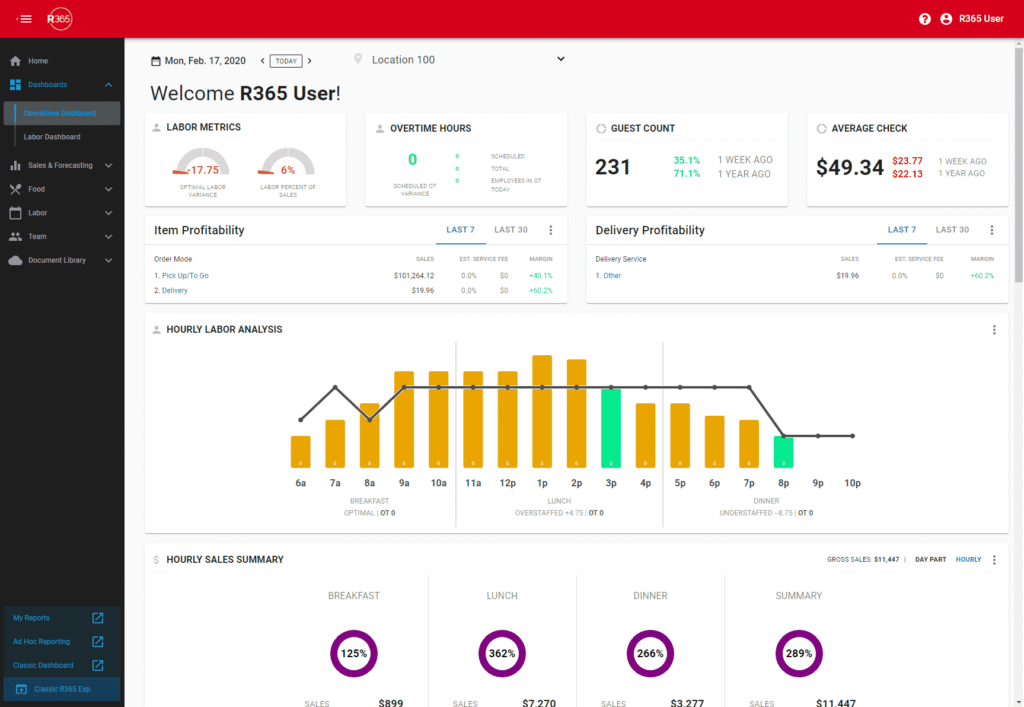
You know efficiency is key when it comes to running a restaurant—and that’s where a restaurant inventory management app really shines. It streamlines operations by integrating inventory management, purchasing, and centralized catalog management for commissary kitchens.
With a tool like this, restaurant owners ensure consistency across their establishments while maximizing efficiency. Plus, its robust reporting capabilities provide valuable insights into costs and margins, empowering owners to make informed decisions that boost profitability.
Bottom line—a restaurant inventory management app is a strategic asset that optimizes operations and enhances profitability in today’s competitive culinary world.
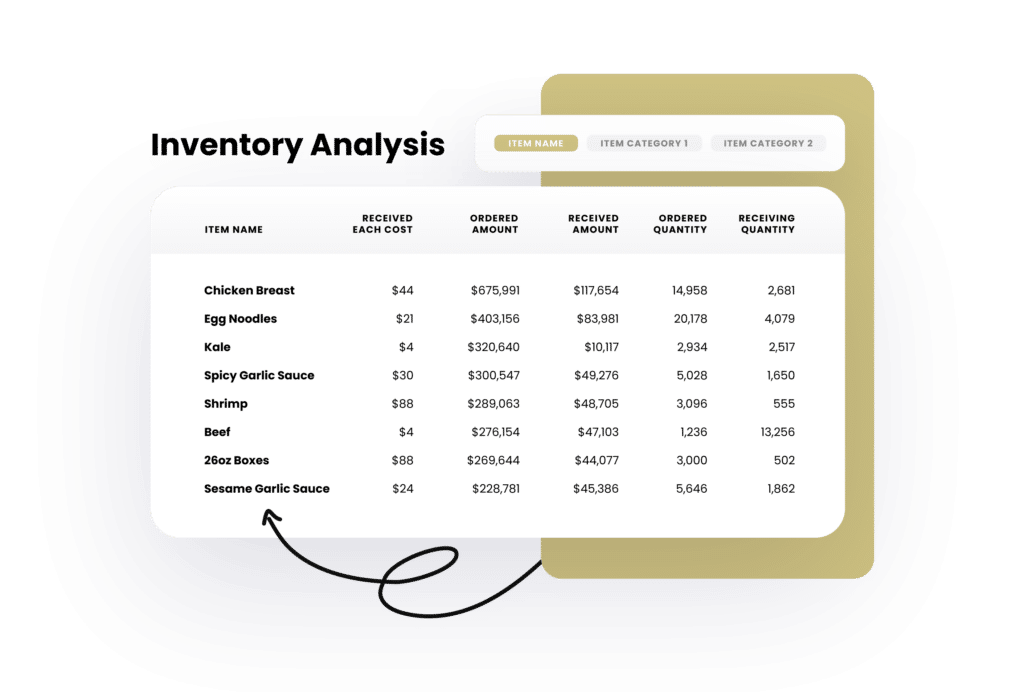
Efficient back of house restaurant scheduling is essential for maintaining smooth operations and maximizing productivity in the kitchen. To achieve this, you’ll need a robust scheduling solution equipped with key features to streamline labor management and enhance employee engagement.
Labor scheduling tools enable managers to create, edit, and communicate schedules easily, considering factors like employee availability and labor laws. Advanced features allow for forecasting based on historical data and demand prediction.
Labor optimization tools help control costs by managing overtime, monitoring labor budgets, and improving workflow efficiency. Employee engagement features promote communication and collaboration, fostering a positive work environment and reducing turnover.
Labor reporting capabilities provide insights into key metrics like labor costs and performance, enabling data-driven decisions to optimize scheduling practices and drive efficiency in the BOH.
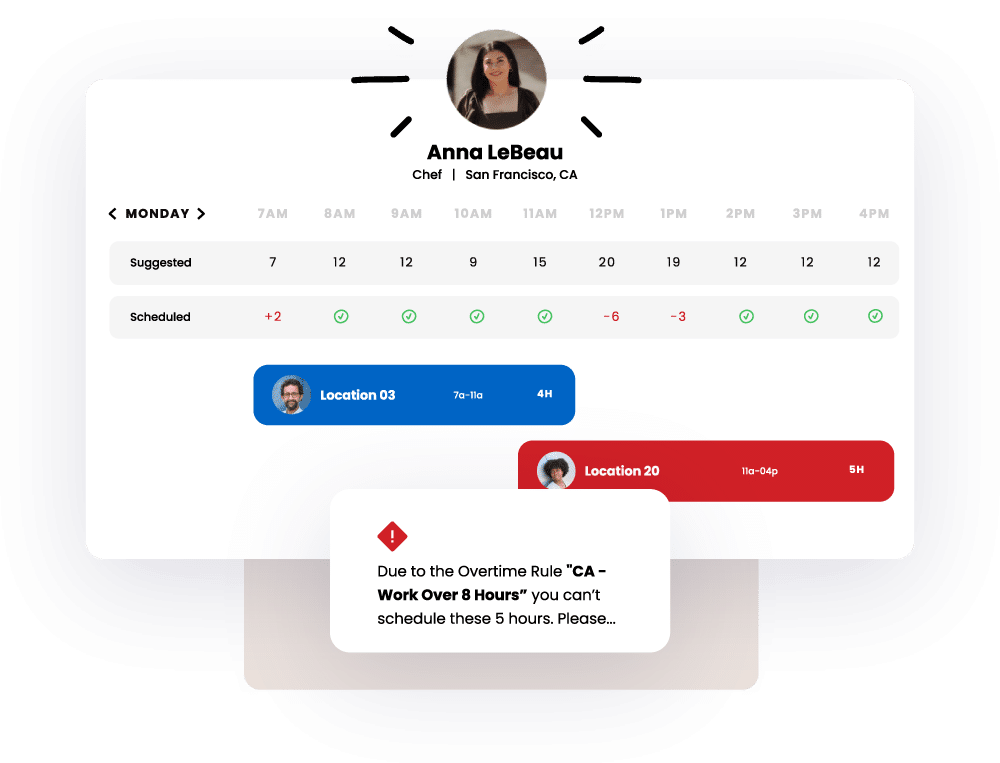
A well-designed back of house payroll system is crucial for restaurants seeking to manage their workforce efficiently. By ensuring speedy and accurate payments, it boosts employee morale and minimizes payroll errors.
With a centralized BOH payroll system, managers can handle payroll tasks from one spot, saving time and reducing errors. Integration with the restaurant’s point of sale (POS) system ensures accurate recording of employee hours and real-time sales data for precise payroll calculations.
Additionally, seamless connection with the general ledger allows for easy tracking of labor expenses alongside other financial data, enabling better decision-making and improved profitability.
Restaurant tip pooling software plays a vital role in the restaurant industry for its tailored automation, adapting to each business’s unique needs. It empowers leaders to adjust tip distribution parameters easily, saving time and ensuring compliance with regulations.
Integrated payroll features simplify tip management for payroll and accounting. This software automates the transfer of POS data, tip rules, and payroll information to relevant departments, guaranteeing accurate tip payments and record-keeping, streamlining processes, and minimizing errors.
Transparent architecture fosters performance, accountability, and retention among restaurant staff. Advanced tip management software formalizes monitoring, promoting transparency and fairness, attracting top talent, and empowering employees with equitable tip distribution practices.
In the restaurant world, you know that consistency and efficiency are everything. That’s where a reliable commissary management platform comes in handy. It helps restaurant groups ensure that every location prepares menu items consistently and uses the same ingredients, all while streamlining operations and boosting profits.
By centralizing major menu item preparation in a commissary, restaurant groups ensure consistent food practices and ingredient usage across all locations. This not only streamlines operations but also enhances the dining experience, fostering guest loyalty and revenue growth.
Key features include:
A comprehensive commissary management platform is more than software—it’s a strategic asset that drives efficiency, consistency, and profitability in restaurant operations.
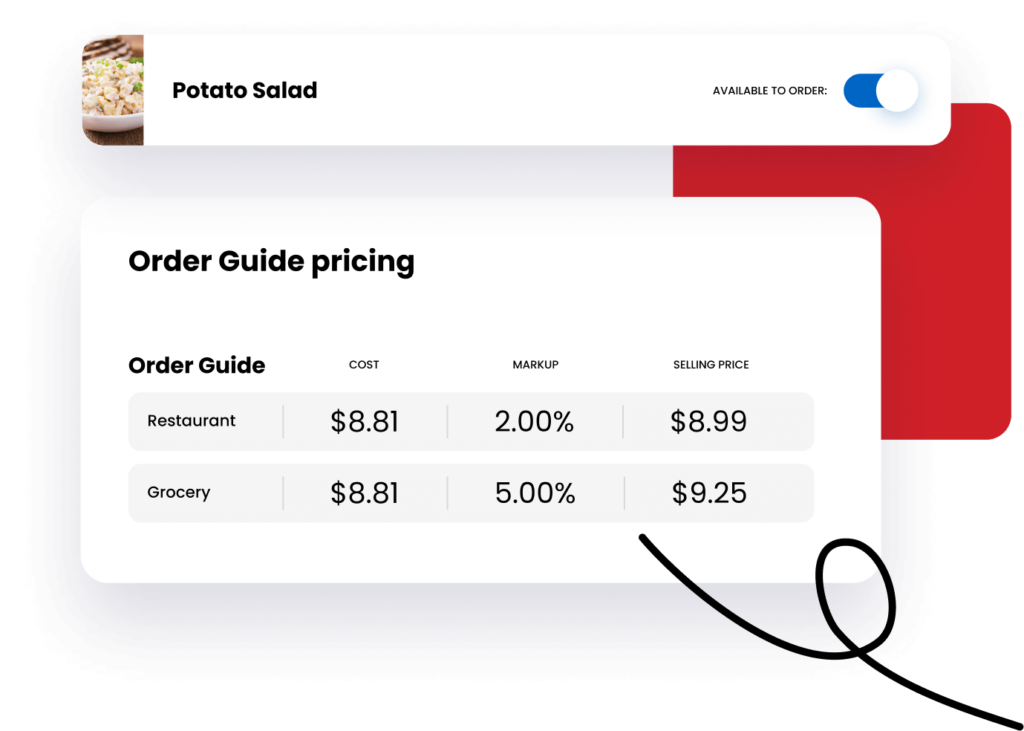
Menu engineering is all about strategically designing restaurant menus to maximize profitability and popularity. By analyzing the profitability and popularity of menu items, restaurants can strategically position their offerings to boost sales and profits.
Automating the menu engineering process makes it easier to visualize item profitability and popularity. With accurate data on each menu item’s sales and margin, restaurants can make informed decisions about menu changes, pricing, and placement.
Menu costing, the initial step in menu engineering, involves analyzing each item’s ingredients to determine its cost accurately. Using menu engineering software streamlines this process, ensuring accuracy and consistency.
Mapping out menu items on a chart helps restaurants see which ones are making the most money and which ones are crowd favorites. With this data, restaurants can make strategic decisions to optimize their menu and increase profitability.
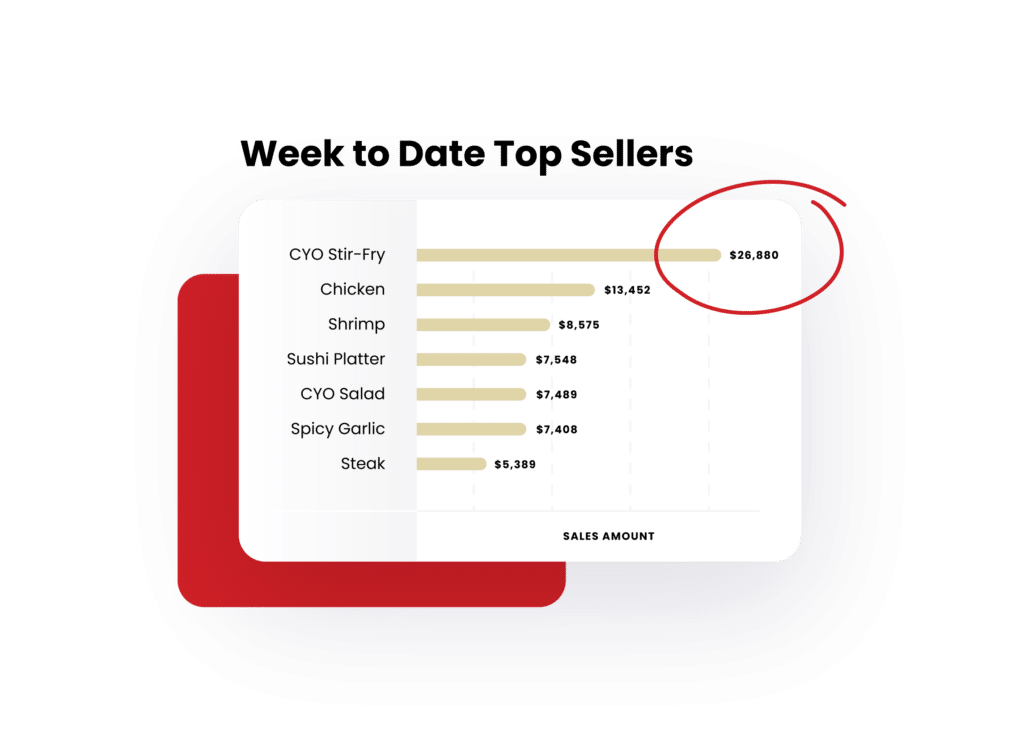
Restaurant accounting software is a valuable tool for driving growth in your restaurant. It streamlines financial processes and provides insights crucial for success. With features like AP automation, it simplifies accounts payable tasks, saving time and reducing errors. Integration with banks offers real-time visibility into financial transactions, enhancing cash flow management.
You can effortlessly track fixed assets, from real property to kitchen equipment, and allocate resources effectively with budgeting and forecasting functionalities across multiple locations. On top of that, financial reporting features can help you visualize your restaurant’s financial health, enabling data-driven decisions. You can also transform bookkeeping into a fast, accurate workflow, to help you generate essential data for efficient and profitable operations.
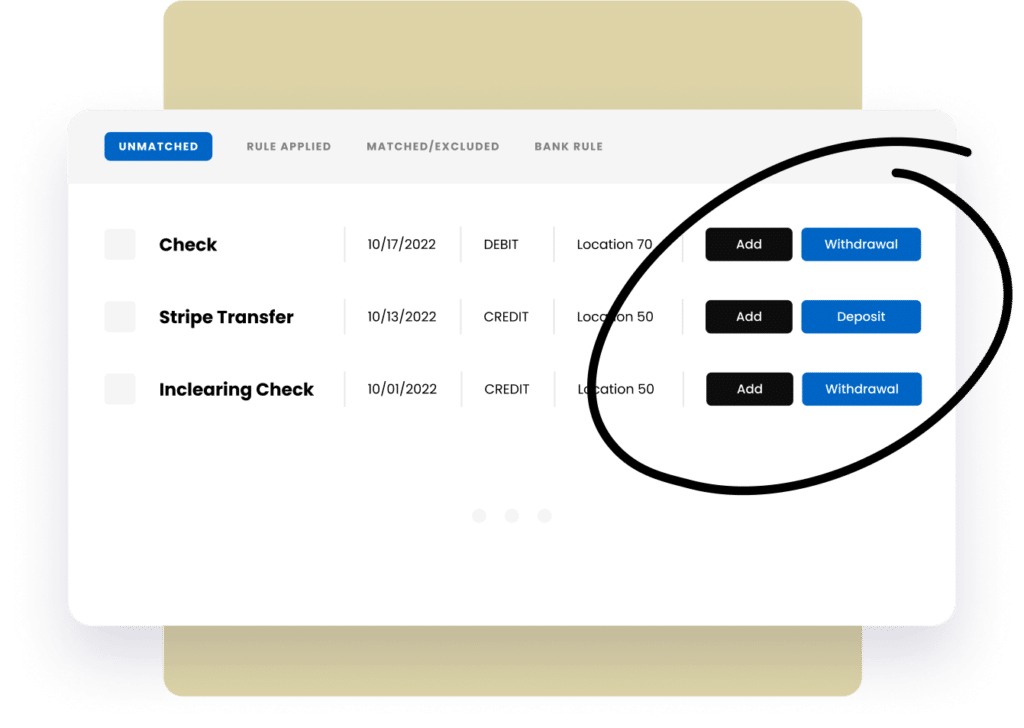
Back of House reporting is something you shouldn’t overlook in your restaurant. It’s like having a trusted advisor that gives you insights to improve how you run things and boost your bottom line. With real-time reporting and analytics, you can make decisions based on what’s happening right now, rather than guessing. Financial dashboards lay out everything from your financial health to sales trends, making it easier to track and manage key metrics.
By analyzing Actual vs. Theoretical food cost, you can find areas where you’re spending too much and figure out how to cut costs without sacrificing quality. Prime Cost reports can show you how your food and labor costs are affecting your overall sales, helping you make smarter decisions to increase profits.
Your back of house reporting should be customized to fit your restaurant’s specific needs. So, whether you’re refining your strategy, streamlining operations, or just looking to improve your bottom line, it’s a tool that can help you achieve your goals.
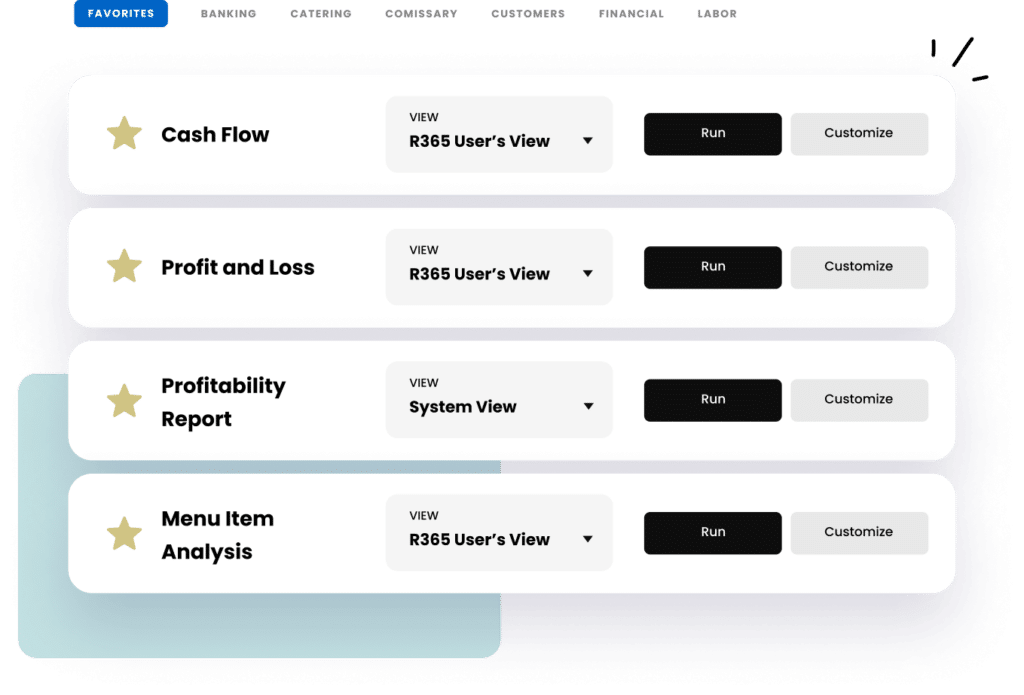
When it comes to managing your restaurant, data is key. With restaurant data, analytics, and intelligence, you can compile and compare POS, sales, and labor data in one place. This intuitive system helps you develop a data-driven strategy to boost profits and enhance guest experiences by driving down Costs of Goods Sold (CoGS) and labor. With intuitive data visualization and customizable dashboards, you can focus on operations instead of number crunching. Plus, collaborative reports empower your entire team by delivering the right metrics to drive sustainable growth across all departments and locations.
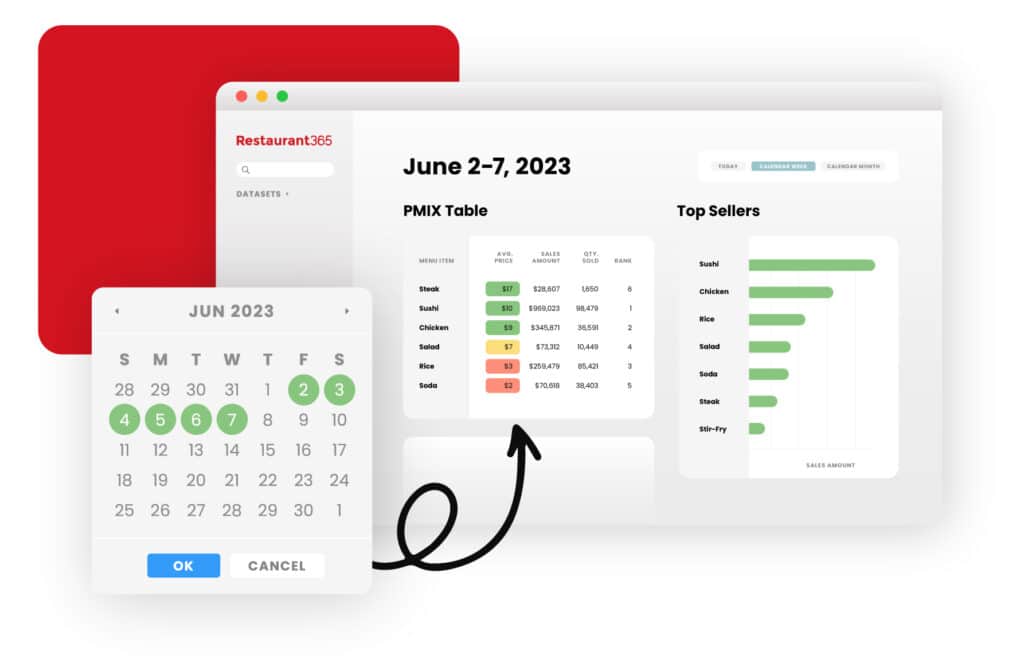
Restaurant labor forecasting is a powerful tool that enables operators to balance store profitability and employee availability effectively. By leveraging granular forecasts based on historical sales data, seasonal trends, and real-time analytics, labor forecasting software can predict staffing needs with remarkable accuracy. This ensures that the restaurant is neither overstaffed or understaffed, optimizing labor costs and enhancing service quality.
Operators can also create more informed schedules that align with peak business hours and employee availability, optimizing labor performance and cost. As a result, this can reduce the risk of burnout and turnover while maintaining a well-staffed operation.
By seamlessly integrating these insights, restaurant operators can turbocharge their bottom line, maximizing both profitability and employee satisfaction.
Restaurant hiring technology offers numerous benefits for operators, streamlining and enhancing the entire recruitment process. Advanced software solutions can automate job postings across multiple platforms, widening the candidate pool and attracting a diverse range of applicants. These tools also employ sophisticated filtering algorithms to quickly identify the best candidates based on predefined criteria, saving time and improving the quality of hires.
Additionally, integrated applicant tracking systems facilitate seamless communication and scheduling of interviews, while digital onboarding features allow new hires to complete necessary paperwork before their first day.
By leveraging these technologies, restaurant operators can reduce hiring costs, expedite the recruitment process, and ensure a higher standard of new employees, ultimately leading to more efficient and effective operations.
Similar to restaurant hiring technology, BOH training platforms are revolutionizing how restaurant operators train their staff, making the process more efficient and consistent.
These digital platforms offer comprehensive, customizable training modules that cover essential areas such as food safety, equipment handling, recipe adherence, and kitchen protocols. By utilizing tutorials, interactive quizzes, and progress tracking, these platforms also ensure that every team member receives the same high-quality training, regardless of their schedule or location.
With a BOH training program, operators not only accelerate the onboarding process but also minimize training costs and reduce errors. Plus, BOH training platforms can be regularly updated to reflect new procedures or menu changes, keeping staff knowledge current and ensuring operational excellence.
Any restaurant owner or manager knows that onboarding new employees can be extremely time-consuming. But with modern technology, BOH staff onboarding becomes significantly more efficient.
With the right restaurant management and HR software, new hires can complete essential paperwork digitally before their first day, streamlining the initial administrative process.
Comprehensive employee training programs can be delivered through online platforms, ensuring consistent education on kitchen protocols, safety standards, and recipe execution. Digital scheduling tools also help new employees quickly acclimate to their work hours and responsibilities.
By leveraging these technologies, restaurants can ensure a smoother, faster onboarding process, which enhances employee readiness, reduces turnover, and promotes a more organized and productive FOH and BOH environment.
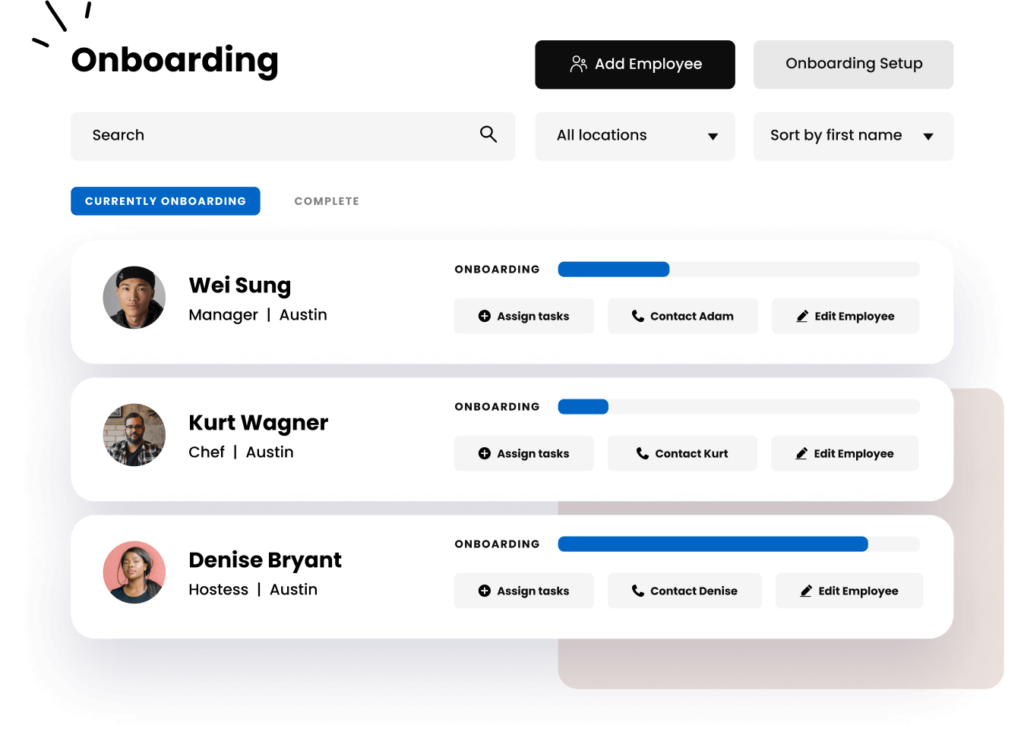
Restaurant reservation systems can greatly improve FOH and BOH alignment. By allowing guests to book tables in advance, these systems help streamline operations, reduce wait times, and improve table turnover rates.
They provide valuable insights into guest preferences and potential dietary restrictions, enabling owners to offer a more personalized dining experience. They can also capture guest information, which can be used to enhance marketing efforts and build stronger customer relationships.
One of the biggest benefits, however, is reservation systems can improve forecasting and scheduling for both the front of house and back of house.
Restaurant scheduling software can simplify the often-stressful task of employee scheduling. It can automate various aspects of the process, such as using schedule templates and tracking labor cost percentage goals. When combined with point of sale (POS) integration and forecasting reports, scheduling software can also help restaurant leaders better understand sales and staffing needs, helping lead to lower labor costs.
When scheduling software is integrated with a restaurant employee app, staff can easily request shift changes or pick up extra shifts, and management can customize the approval workflow. This software not only supports employees’ needs but also saves the management team significant time and effort. Plus, by providing greater flexibility and control over staff schedules, it can help reduce employee turnover, leading to a more stable and satisfied team.
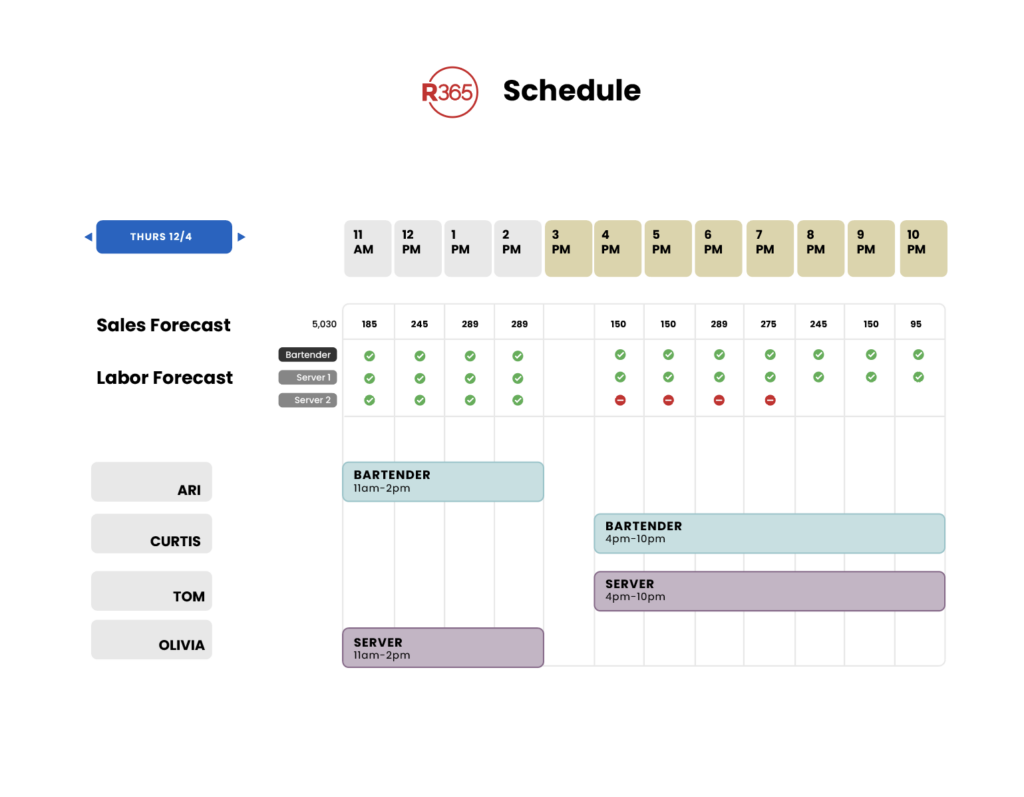
Point of sale (POS) solutions are essential for restaurant operations — and with the rise of cloud-based POS systems and management platforms, POS integration is crucial.
POS integration connects POS software with a restaurant’s accounting and operations platform. This connection allows the operations platform to retrieve detailed data from the POS in real time, automatically updating daily sales and labor data into the accounting general ledger.
This integrated approach provides more than just basic cash drawer summaries, offering critical insights for sales reporting, menu engineering, recipe costing, labor management, and business analytics.
By integrating a POS with an accounting platform, operators can centralize data collection, eliminate manual entry, minimize errors, and save precious time. POS integration can also support business strategy with customized reporting and real-time financial insights, enabling operators to address any issues immediately.
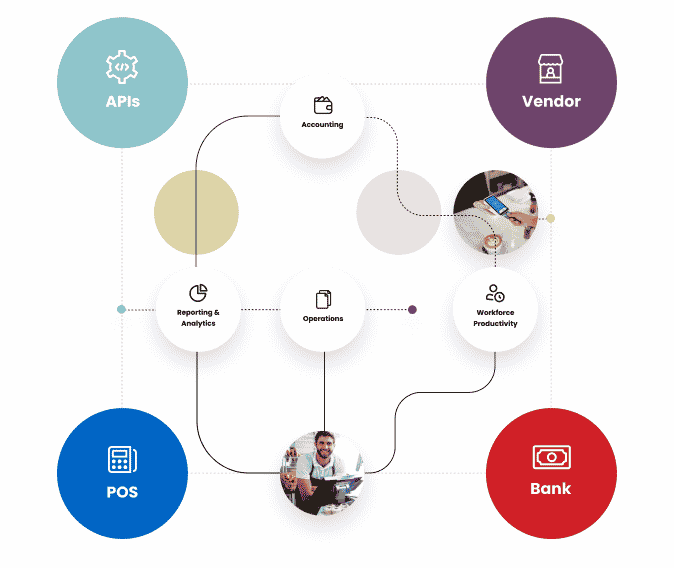
Restaurants generate a wealth of data from sales revenue, food costs, and labor hours, and it’s up to managers to leverage this data effectively. By combining front of house (FOH) and back of house (BOH) data, operators can gain valuable insights into their operations.
Here are some KPIs to monitor:
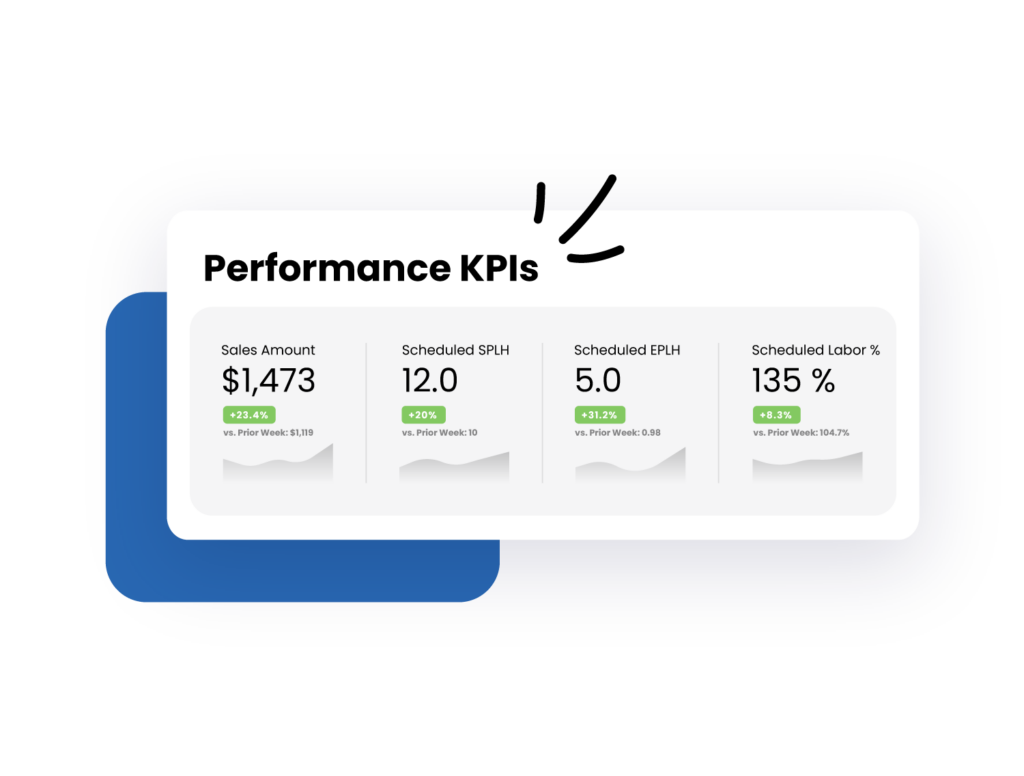
Navigating restaurant data can feel overwhelming but starting with a few key BOH reports can make a significant impact. Focusing on critical KPIs such as inventory control, menu item performance, and labor cost management helps address the most pressing areas first.
By unifying FOH and BOH data with modern restaurant software, operators can gain a comprehensive view of their restaurant’s overall accounting and operations. This holistic approach helps spot trends, identify inefficiencies, and make data-driven decisions that enhance profitability and boost the guest experience.
An Inventory Count Variance (ICV) Report is a detailed document that tracks discrepancies between the expected and actual inventory levels of specific items. It compares the theoretical inventory, based on sales and usage data, with the physical inventory count conducted at regular intervals.
This report identifies variances that may indicate issues such as over-portioning, theft, waste, or inaccuracies in inventory tracking.
By highlighting these discrepancies, AN ICV Report helps restaurant managers pinpoint areas where inventory management practices can be improved, ultimately reducing costs and increasing efficiency. It serves as a crucial tool for maintaining accurate inventory control, ensuring that the restaurant operates smoothly and profitably.
A Menu Engineering Report is a strategic tool used to analyze and optimize a restaurant’s menu for both profitability and popularity. It analyzes the sales volume of each item to identify guest favorites and assesses the profit margin to determine how much profit each dish generates.
Menu items are then categorized into various segments:
Based on these categories, the report provides actionable insights and recommendations for menu redesign, pricing strategies, and marketing efforts to enhance overall profitability. The data is often presented in charts or graphs for easier interpretation and decision-making.
Ultimately, a menu engineering report helps restaurant owners and managers understand the financial performance of their menu items, enabling them to make strategic adjustments to maximize both profitability and guest satisfaction.
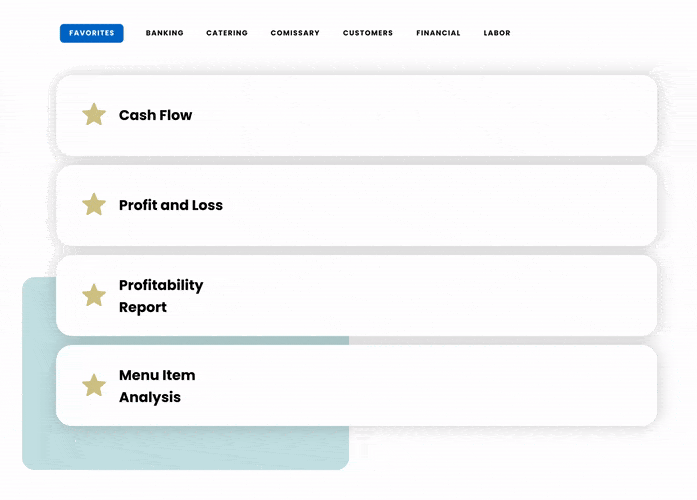
A Menu Item Contribution Report is a detailed analysis that assesses the profitability of each menu item at a specific restaurant. It breaks down the cost of all ingredients used in each dish, often referred to as the theoretical cost, and compares the actual food cost percentage of each item to the target cost percentage set by the restaurant. This comparison helps identify items that are not meeting profitability goals.
The report also evaluates how much profit each menu item contributes to the overall revenue of the restaurant. By highlighting items with higher-than-target costs, it helps identify opportunities to reduce expenses, such as switching suppliers or adjusting recipes.
Providing a comprehensive look at the menu, the report allows operators to make informed decisions about pricing, menu adjustments, and cost management. Overall, a Menu Item Contribution Report enables restaurant owners and managers to optimize their menu for maximum profitability by offering a clear picture of where money is being made or lost on individual menu items.
A Flash Report is a summary of key financial and operational metrics for a restaurant, typically generated daily or weekly. It provides a snapshot of a restaurant’s performance in areas such as sales, labor costs, food costs, profitability, and other important indicators. Though it doesn’t include inventory costs or other cost of goods metrics, it can deliver critical insights into a restaurant’s biggest variable expense: labor.
Flash reports are often used by restaurant managers and operators to quickly assess how a business is performing. They can identify any areas that may require immediate attention or improvement, settling operational issues before they become long-term problems that affect profit margins.
Monitoring vendor pricing is crucial for managing food costs effectively. With a Received by Purchased Item Report, operators can detect any pricing discrepancies beyond agreed-upon rates with vendors, enabling prompt action to rectify contract breaches. They can also use this report to compare prices across different locations, spot differences between stores or regions, and understand how each item contributes to the overall Cost of Goods Sold (COGS). This allows them to identify popular items that may need closer monitoring as well as stay on top of vendor pricing.
For example, vendors often implement tiered pricing structures, offering automatic discounts based on ordered quantities. If the Received by Purchased Item Report reveals that a vendor charges $3.36 per pound for avocados in a 5 lb. case but only $3.00 per pound in a 30 lb. case, an operator who anticipates using 30 lbs. or more before the next order would benefit from the larger case, resulting in significant savings.
While seemingly minor, these cumulative savings can substantially impact overall expenses when applied across an entire menu.
Analyzing the Labor Actual vs. Scheduled Report helps operators grasp the difference between planned and real labor costs — which are one of the most significant operational expenses for restaurants.
This report compares scheduled labor costs with actual labor expenses at a specific location over a defined period. It also provides actionable details related to the data points, like the job titles, exact date, and employee name, allowing operators to more easily identify and correct the issue(s).
For instance, early clock-ins can significantly impact costs. If 20 BOH employees, each earning $12/hour, clock in 10 minutes early daily, it incurs an additional $40 in wages per day or $14,600 annually. By identifying this issue with a labor actual vs. scheduled analysis, operators can implement a solution like adjusting the POS system to limit early clock-ins without managerial approval.
An Actual vs. Theoretical (AvT) Report digs into the quantity and cost of a restaurant’s ingredient inventory and menu. By comparing the cost of ingredients used in dishes against the theoretical cost based on recipes and portion sizes, restaurants can identify variances and pinpoint areas for improvement. This analysis helps managers control expenses, optimize menu pricing, reduce waste, and maintain profitability. Up-to-date AvT variance reporting can also flag improper usage before it becomes a daily occurrence, helping staff learn and stay on track by implementing changes virtually on the spot.
By using an all-in-one restaurant management platform, operators can quickly generate customized reports on actual versus theoretical food costs and make immediate adjustments. With this tracking system in place, operators can make data-driven decisions about food costs, implement efficiencies, and regain lost profits.
The backbone of any restaurant lies in its BOH operations. From managing inventory and controlling costs to ensuring quality standards are met, the BOH plays a critical role in a restaurant’s overall success. By dedicating resources to training, technology, and process improvement within the BOH, owners and operators can enhance productivity, streamline operations, and, ultimately, improve profitability.
Bottom line: Invest in your BOH team, equip them with the best tools, and watch your restaurant thrive.
Share this blog:
See why more than 40,000 restaurants use Restaurant365
500 Technology Drive, Suite 200
Irvine, CA 92618
Westech 360
8911 N Capital of Texas Hwy
Building 1, Suite 1200
Austin, TX 78759
Restaurant365 bridges the gap between accounting and operations by centralizing all data, helping restaurant operators to become more efficient, accurately forecast, and tackle any challenge or opportunity with speed and accuracy.